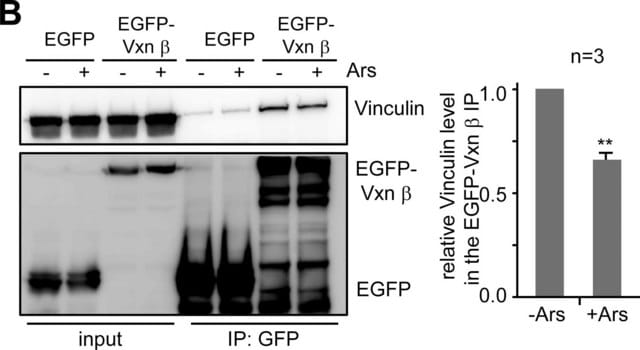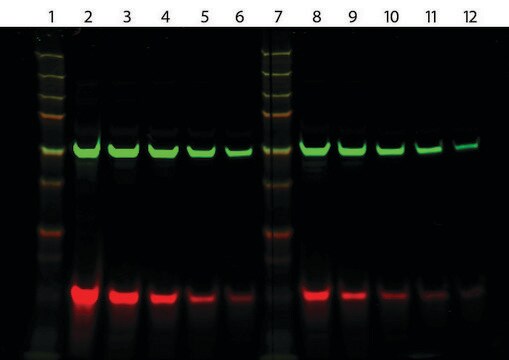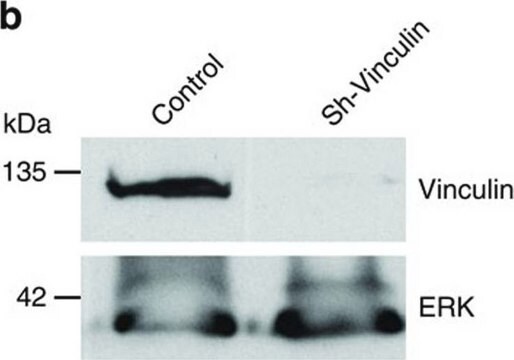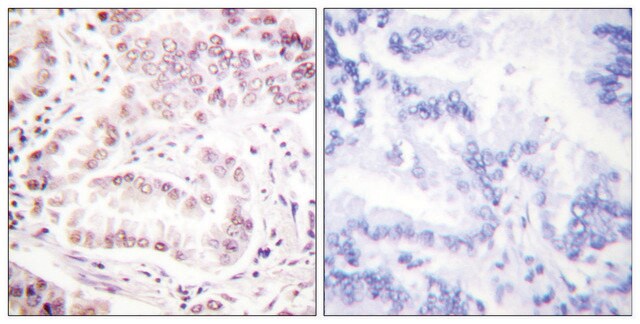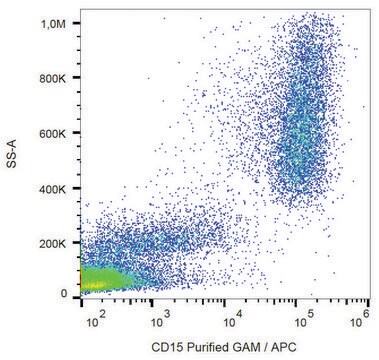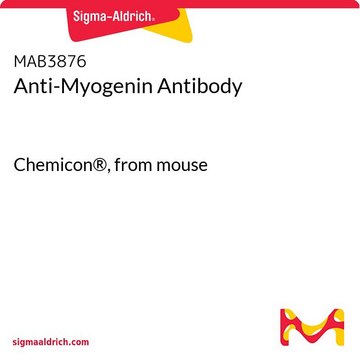SAB4700284
Monoclonal Anti-CD15 antibody produced in mouse
clone MEM-158, purified immunoglobulin, buffered aqueous solution
Synonym(s):
Anti-FUT4, Anti-Lewis x Blood Group antigen
Sign Into View Organizational & Contract Pricing
All Photos(1)
About This Item
UNSPSC Code:
12352203
NACRES:
NA.41
Recommended Products
biological source
mouse
Quality Level
conjugate
unconjugated
antibody form
purified immunoglobulin
antibody product type
primary antibodies
clone
MEM-158, monoclonal
form
buffered aqueous solution
species reactivity
human
concentration
1 mg/mL
technique(s)
flow cytometry: suitable
isotype
IgM
NCBI accession no.
UniProt accession no.
shipped in
wet ice
storage temp.
2-8°C
target post-translational modification
unmodified
Gene Information
human ... FUT4(2526)
General description
Cluster of differentiation 15 (CD15), also known as fucosyltransferase 4 (FUT4)/ Lewis x blood group antigen, is encoded by the gene mapped to long arm of human chromosome 11q21. It is ubiquitously expressed in various tissues such as gastrointestinal tract, brain and leukocytes.
The antibody MEM-158 reacts with CD15, a cell membrane molecule 3-fucosyl-N-acetyllactosamine (3-FAL) strongly expressed on granulocytes, monocytes, macrophages, mast cells; it is also present on Langerhans cells and some myeloid precursors cells.
Immunogen
Human granulocytes
Application
The reagent is designed for Flow Cytometry analysis using 10 μL reagent / 100 μL of sample.
Biochem/physiol Actions
Cluster of differentiation 15 (CD15)/fucosyltransferase 4 catalyzes the synthesis of Lex on the surface of the proliferating cells, in organ buds progressing in mesenchyma, during human embryogenesis. Overexpression of the gene has been associated with development of various type of cancers such as colon cancer, pancreatic cancer, gastric cancer and lung adenocarcinoma. siRNAs of FUT1/4 can be used as a potent therapeutic agent in human LeY-expressing cancers.
Features and Benefits
Evaluate our antibodies with complete peace of mind. If the antibody does not perform in your application, we will issue a full credit or replacement antibody. Learn more.
Physical form
Solution in phosphate buffered saline, pH 7.4, with 15 mM sodium azide.
Disclaimer
Unless otherwise stated in our catalog or other company documentation accompanying the product(s), our products are intended for research use only and are not to be used for any other purpose, which includes but is not limited to, unauthorized commercial uses, in vitro diagnostic uses, ex vivo or in vivo therapeutic uses or any type of consumption or application to humans or animals.
Not finding the right product?
Try our Product Selector Tool.
Storage Class Code
10 - Combustible liquids
Flash Point(F)
Not applicable
Flash Point(C)
Not applicable
Choose from one of the most recent versions:
Already Own This Product?
Find documentation for the products that you have recently purchased in the Document Library.
Suppression of FUT1/FUT4 expression by siRNA inhibits tumor growth
Zhang Z
Biochimica et Biophysica Acta, 1783, 287-296 (2008)
Brandon G Ginley et al.
Scientific reports, 7(1), 17755-17755 (2017-12-21)
Neutrophil extracellular traps (NETs) are extracellular defense mechanisms used by neutrophils, where chromatin is expelled together with histones and granular/cytoplasmic proteins. They have become an immunology hotspot, implicated in infections, but also in a diverse array of diseases such as
Erin A Henslee et al.
Nature communications, 8(1), 1978-1978 (2017-12-08)
Circadian rhythms organize many aspects of cell biology and physiology to a daily temporal program that depends on clock gene expression cycles in most mammalian cell types. However, circadian rhythms are also observed in isolated mammalian red blood cells (RBCs)
Xiao-Fei Kong et al.
Nature immunology, 19(9), 973-985 (2018-08-22)
Human inborn errors of IFN-γ immunity underlie mycobacterial diseases. We describe patients with Mycobacterium bovis (BCG) disease who are homozygous for loss-of-function mutations of SPPL2A. This gene encodes a transmembrane protease that degrades the N-terminal fragment (NTF) of CD74 (HLA
David Weisenburger-Lile et al.
Neurology(R) neuroimmunology & neuroinflammation, 6(4), e571-e571 (2019-07-30)
To better understand the functional state of circulating neutrophils in patients with ischemic stroke (IS) for planning future clinical trials. We analyzed by flow cytometry activation state of circulating neutrophils and the distribution of neutrophil peripheral subsets in 41 patients
Global Trade Item Number
| SKU | GTIN |
|---|---|
| SAB4700284-100UG | 4061832706764 |
Our team of scientists has experience in all areas of research including Life Science, Material Science, Chemical Synthesis, Chromatography, Analytical and many others.
Contact Technical Service
